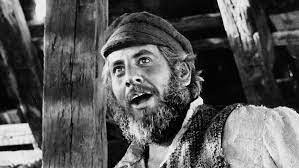
I was born and raised in a small town in the Adirondacks called Mayfield. In elementary school, I was the only Jew in my class. When we sang in the school assembly in December, we sang several Christmas carols; but to make sure I didn’t feel like the odd one out, the teachers included two songs about Hannukah. All the students would look at me and smile as we sang. After an anti-semitic incident in junior high, I transferred to a nearby school, in Gloversville, New York where I went to Hebrew school and was bar-mitzvahed (in that school, I was one of three Jews in my grade).
Why do I mention any of this in a reflection on Chaim Topol?
Both of my parents and most of my family are Jews from New York City. But besides Annie Hall (1977), Mad Magazine, and Hebrew School classes after school that I barely focused on (save for the units on the Holocaust), I had little exposure to Jewishness as a child. The movie, Fiddler on the Roof (1971), however, was one of the most Jewish things I ever saw. It was even staged at one of my schools. The songs, the dancing, the story all intrigued me and made me feel ok about being an American Jew. My non-Jewish videographer included parts of the soundtrack in my Bar Mitzvah Video (at the beginning and end). It seemed to have brought me into an appreciation of “tradition” and life.
Later in life, after I was an undergrad, I found out for myself what Judaism was all about by going to Yeshiva and taking on a more observant lifestyle. Be that as it may, it was this film that gave me my first vague sense of what Jewishness I came from…in old Europe. I always wondered what life was like there, before the Holocaust.
I was intrigued with the Tevye character played so wonderfully by Chaim Topol. He was so full of life, so reflective, honest, and self-deprecating. Since Woody Allen’s and Mel Brooks’ films, as well as Mad Magazine, were my pop cultural guides to Jewishness, I always wondered how Tevye measured up. Was he a schlemiel like most characters in these films or caricatures in Mad?
We need to look at the original inspiration for the Broadway / Hollywood character by turning to Shalom Aleichem, who wrote these stories in the wake of pogroms and before the Holocaust.
Ruth Wisse, in The Schlemiel as Modern Hero, doesn’t think so. She contrasts Tevye to the character Menahem Mendel and sees Tevye as the embodiment of a schlemiel (who lacks insight into his condition) and his opposite (who does). Tevye, unlike the schlemiel character, experiences “ironic resignation” while also having an “elemental life instinct”:
I.L. Trunk distinguishes between these two heroes: Menahem Mendl, he says, is pure instinct. Unlike Tevye the Dairyman, he does not experience ironic resignation, or ironic faith: he ‘expresses the elemental life instinct which does not see its tragic perspectives.” But taken together, Menahem Mendl and his wife Sheyne Sheyndl, do create the ironic juxtapositions that Tevye expresses in his own person, allowing the reader to weigh the fierce optimism against a tragic perspective. Together they represent two extremes of faith and failure. (56)
For Sander Pinsker, in his book The Schlemiel as Metaphor, Tevye is a character who “best captures the tragic-comic sprit of the Diaspora”(32) when he says, “With God’s help I starved to death – I and my wife and children – three times a day, not counting supper”(32). Pinsker says – playing on Nietzsche in the Birth of Tragedy – that Tevye gives “tragic affirmation a new twist.”
For Pinsker, like Wisse, Tevye is a figure of faith:
With the world of the shtetl all but disintegrated and ‘modern children’ threatening to abandon its traditions entirely, Tevye not only continues to pattern his life on the Old Ways, but he also has a perfect faith that the Old Ways will somehow prevail. (36)
But he is a schlimazel because history ruins his life and his family. He loves them all, but he is the last person to preserve faith in the midst of rapid change. Aleichem wrote these tales before the Holocaust. That Europe is gone. But the spirit of Tevye, so beautifully embodied and preserved for the ages by Chaim Topol is with us.
What I loved about Chaim Topol’s performance of faith was how he embodied it through his acting. His joy and his tribulations, embodied through his “tragic affirmation,” gave me hope. One can be bold and Jewish in America, I thought, but how? Through theater? Literature? Film? A religious life?
To be sure, the film and the play are a part of what Sidrah DeKoven Ezrahi, in her book, Booking Passage: Exile and Homecoming in the Jewish Imagination, of a general post-WWII construction of a “virtual shtetl” – as we see with the popularity of I.B. Singer’s fiction, Irving Howe’s World of our Fathers, his Yiddish Anthology, new translations of Yiddish writers, etc – which emerged after the European shtetl and its Jewish culture were obliterated by the Nazis. For her, it is a form of nostalgia since that world is gone for good.
Be that as it may, the film and play touched the hearts of millions of people, Jews and non-Jews. Topol gave it new meaning and purpose. It is a past that means a lot to us insofar as we imagine it to be on the threshold of a rich Yiddish culture and an ancient faith that was challenged by history, pogroms, anti-semitism, etc. The point is to remain strong in the face of it all and to make a “tragic affirmation” of faith when it seems to have run its course.
Rest in peace, Chaim. Baruch Dayin Ha’emes.
You changed the world and gave us an embodiment of Jewish life, faith, and culture that inspired many Jews, like myself, to look deeper into their Jewishness.
